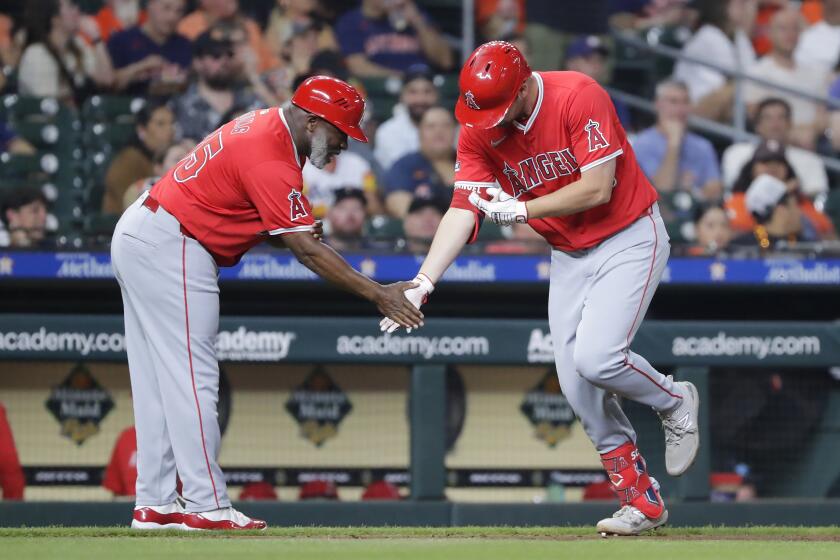New Ticket Prices Giving Sockers Fans Case of Cold Feet : Soccer: Season ticket sales and attendance are down through first four home games.
During the summer, the Sockers hit their patrons with higher prices. Now the patrons are punching back.
Season ticket sales are down and, after four home games, so is attendance. The four-game turnstile count of 33,420 at the Sports Arena is down 3,723 from last season.
If the drop-off continues, the Sockers’ average attendance would fall for the sixth time in the past seven years and would tumble below 8,000 for the first time since 1981-82, when the average draw was 7,047.
Unless last year’s trend--in which crowds dwindled as the season wore on--reverses, the Sockers will finish with an average of 7,201.
After 26 home games last year, the average stood at 8,131. But attendance trailed off as the season neared the playoffs. Two of the first four games attracted more than 11,000. But after that, the Sockers drew only one crowd in excess of 10,000, none beyond 11,000.
And that was before fears of recession rocked the economy and before the price of lower-level tickets increased.
Of those two factors, the economy and ticket costs, Sockers President Ron Cady said the recession gets most of the blame for his team’s attendance woes.
“Season tickets are down,” Cady said, “but that’s an effect of the economy. We didn’t get any negative feedback on the price increase.”
Yet there was negative feedback in the bottom line. Last year 3,180 season tickets were sold. This year the number stands at 2,250.
“A significant drop,” Cady said.
Although the Sockers’ survey of 800 former season ticket-holders might not broach the subject, trends during the past seven years suggest price changes affect ticket sales.
Ticket prices have been hiked in six of the past seven years, and in each of the six years of hikes, average attendance slipped.
The kicker here is that the only gain in average attendance came in 1986-87, the one season in which ticket prices were lowered from the previous year.
It was a modest gain, 166 per game, but the drop in price was also modest. The lower-level seats remained unchanged while some seats in the top level sold for $7 and others for $5, a difference of $1 to $3 from the previous season.
In 1987-88, the $5 seat was eliminated.
Another example that lower costs attract more customers unfolded last week when the team drew only 4,490 for a Thursday night game, then packed in 11,316 two days later. The difference was that the Sockers sold out the upper deck for the second game by offering $5 tickets to youth soccer players.
“The Sockers should have never stopped offering $5 seats,” a former marketing employee of the team said. “They should have reserved fewer and fewer seats for $5 each year, but still kept them so they could advertise tickets starting at $5. That way even if they sell out of $5 tickets, they’ve drawn parents with their kids to the ticket windows. What are parents going to tell their kids? That they have to go home? No, they’ll buy the higher-priced tickets.”
Cady said the club has thought about lowering ticket prices.
“We have looked at that in the past,” he said. “But when we had $5 seats, everyone bought those tickets and then moved down into the lower section. . . . You dilute the quality of the product if you offer too low of a price on tickets.”
Cady said instead of lowering ticket prices, the club has decided to discount them, offering cheaper rates to juniors (age 19 and under), seniors (55 and over), military personnel, families and to large groups.
The cost of tickets and the shaky economy aside, there appear to be at least five other factors in the continuing decline in attendance:
* Poor perception of the league. For the third consecutive summer, the MSL teetered on collapse, which not only further tarnished its image but played a direct role in the Sockers’ smaller crowds.
Cady said the Sockers “lost 60 days of selling” when Milan Mandaric, owner of the St. Louis Storm, insisted he was going to fold his club. Other owners, including the Sockers’ Ron Fowler, said if Mandaric closed shop, they would follow. Thus, the Sockers’ sales and marketing efforts were abandoned for a time.
In the end, no team went under, but the summer’s uncertainty seems to have affected all eight clubs and has spawned one of the many paradoxes for which the league is often chided:
Despite their crumbling crowds, the Sockers actually lead the league in attendance.
* Too little offense. Whether defenses have improved or the game is losing its scoring heroes--or both--there have been fewer goals.
Teams combined for an average of 12 goals per game in the inaugural season, 1978-79. Last year an average of eight goals were scored in each game.
League owners, however, remedied the decrease by enlarging the goal two feet in width and one foot in height and by requiring defenders to back off 15 feet on all free kicks, rather than 10 as in the past.
At last count, scoring was up 34% from last year to 10.64 goals per game.
Now owners must sit back and hope others take notice.
“The idea behind the new rules,” Cady said, “was to attract new fans. We thought if we could increase scoring, someone new to the game might say to himself, ‘Gosh, maybe indoor soccer is something I’d like to go see.’ ”
* Poor TV exposure. If a new fan is going to discover indoor soccer, the league needs TV.
But the MSL has never had a legitimate national television contract. It has been on ESPN, but games were delayed by more than a week in some instances. This year, an arrangement has been worked out with SportsChannel America, a small cable outlet that currently is beamed to only one MSL market, Cleveland.
Locally, Sockers games have been on Prime Ticket, a cable-only station, since 1985-86 and therefore TV games have not been available to all San Diego households.
“I think that definitely had an impact,” the former Sockers marketing employee said. “I think they lost the casual fans when they went to Prime Ticket.”
The Sockers’ association with Prime Ticket, however, ended last season and the team recently announced a six-game package with KUSI Ch. 51 that will begin with a Dec. 22 game at Baltimore.
“Now they’ll have the casual fan back again,” the ex-employee said. “If they run a promo for a Sockers-Sidekicks game during, say, ‘Cosby,’ a lot more people will see that than will ever see Prime Ticket.”
Cady said he is eager for the televised games to begin.
“We just have to get through the first eight home games (without the benefit of TV),” Cady said. “Then through the next 18, I feel very confident things will really start to pick up (because of TV).”
* Competition. For the first time since the National Basketball Assn. Clippers left in 1984, there’s another winter team vying for the sports fan’s dollar--the Gulls of the International Hockey League.
Cady said the Sockers lost 15 accounts (each account averages 2.2 season tickets) to the Gulls.
“Which is a negligible loss due to the Gulls,” Cady said.
Actually, Cady and Don Waddell, general manager for the Gulls, said the presence of two teams eventually will help each at the gate.
“With two teams, you get people in the habit of coming to the arena,” Waddell said.
Added Cady, “It’s like the old restaurant theory. You have a lot of restaurants in one area and people going to one look up and say, ‘Hey, look at that new restaurant over there. Next time let’s try that one.’ ”
* Too many games. The one flaw in the old restaurant theory is that most people have a limited entertainment budget. Just how many games can a fan afford to attend?
Let’s see:
The Sockers all-time high in attendance came in 1983-84 when the club was forced to forgo the Major Indoor Soccer League season in favor of the North American Soccer League’s 32-game indoor schedule. The Sockers had only 16 home games to sell that year and drew an average of 11,415.
The next season, the Sockers realigned with the MISL and played 24 home games. Average attendance dropped by 1,820, the largest single-season fall.
The second biggest fall came in 1987-88 when the MISL decided on its most ambitious schedule and gave each team 28 home dates. The Sockers’ average crowd that year was 8,996, a drop of 751 from the previous season.
The Sockers currently play 26 home games.
“There are a lot of things to do in San Diego,” Cady said. “And very possibly going to a soccer game two days a week really isn’t a viable choice.”
Cady also said there is a downside to paring the season.
“You’re giving up receipts by cutting down the season,” he said.
SOCKERS’ ATTENDANCE Sockers’ attendance, with two factors that might affect it, ticket prices and the amount of offense (in combined goals per game):
Season Avg. Attend. Dates Change Ticket Prices Comb.Offense 1980-81 4,912 9 -- Unavailable * 1981-82 7,047 9 +2,135 Unavailable * 1982-83 8,081 24 +1,034 Unavailable 10.41 1983-84 11,415 16 +3,334 Unavailable * 1984-85 9,595 24 -1,820 $10, $8 9.64 1985-86 9,581 24 -14 $11, $10, $9, $8 9.52 1986-87 9,747 26 +166 $11, $10, $9, $7, $5 8.85 1987-88 8,996 28 -751 $11, $9, $7 8.91 1988-89 8,383 24 -613 $12.50, $10, $7 8.64 1989-90 8,132 26 -251 $12.50, $10.50, $8 8.06 1990-91 ** 8,355 4 -- $16, $13, $10.50, $8 10.64
* -- Not Applicable because Sockers played in the NASL. ** -- Average through first four home dates of this season. That average reflects a decrease of 931 over the first four home dates of last season.
More to Read
Get our high school sports newsletter
Prep Rally is devoted to the SoCal high school sports experience, bringing you scores, stories and a behind-the-scenes look at what makes prep sports so popular.
You may occasionally receive promotional content from the Los Angeles Times.






